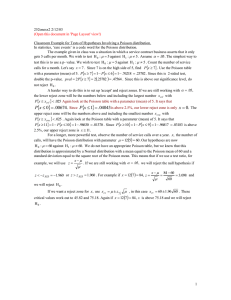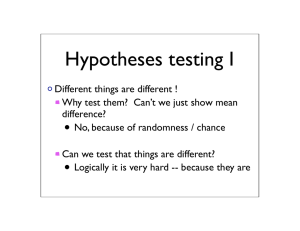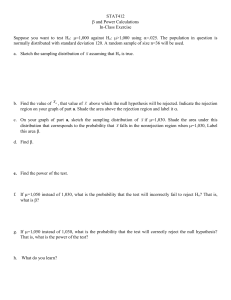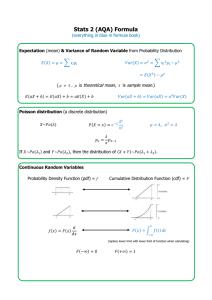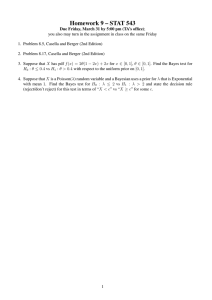Document 15930219
advertisement
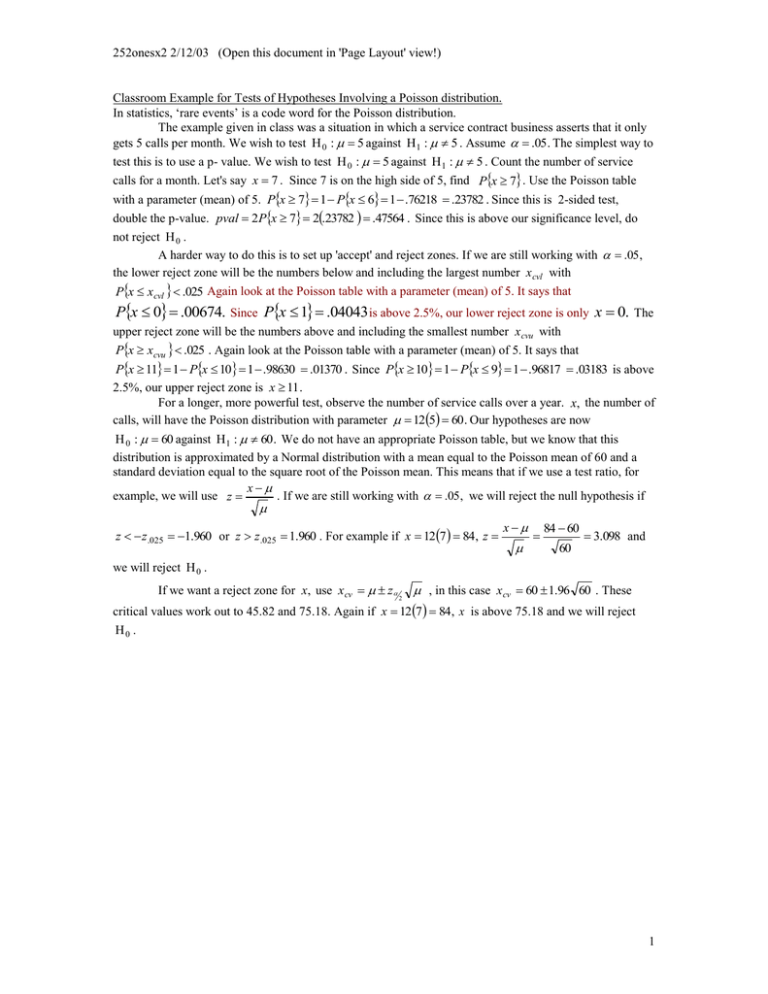
252onesx2 2/12/03 (Open this document in 'Page Layout' view!) Classroom Example for Tests of Hypotheses Involving a Poisson distribution. In statistics, ‘rare events’ is a code word for the Poisson distribution. The example given in class was a situation in which a service contract business asserts that it only gets 5 calls per month. We wish to test H 0 : 5 against H 1 : 5 . Assume .05 . The simplest way to test this is to use a p- value. We wish to test H 0 : 5 against H 1 : 5 . Count the number of service calls for a month. Let's say x 7 . Since 7 is on the high side of 5, find Px 7 . Use the Poisson table with a parameter (mean) of 5. Px 7 1 Px 6 1 .76218 .23782 . Since this is 2-sided test, double the p-value. pval 2Px 7 2.23782 .47564 . Since this is above our significance level, do not reject H 0 . A harder way to do this is to set up 'accept' and reject zones. If we are still working with .05, the lower reject zone will be the numbers below and including the largest number x cvl with Px x cvl .025 Again look at the Poisson table with a parameter (mean) of 5. It says that Px 0 .00674. Since Px 1 .04043 is above 2.5%, our lower reject zone is only x 0. The upper reject zone will be the numbers above and including the smallest number x cvu with Px xcvu .025 . Again look at the Poisson table with a parameter (mean) of 5. It says that Px 11 1 Px 10 1 .98630 .01370 . Since Px 10 1 Px 9 1 .96817 .03183 is above 2.5%, our upper reject zone is x 11 . For a longer, more powerful test, observe the number of service calls over a year. x, the number of calls, will have the Poisson distribution with parameter 125 60 . Our hypotheses are now H 0 : 60 against H1 : 60 . We do not have an appropriate Poisson table, but we know that this distribution is approximated by a Normal distribution with a mean equal to the Poisson mean of 60 and a standard deviation equal to the square root of the Poisson mean. This means that if we use a test ratio, for x example, we will use z . If we are still working with .05, we will reject the null hypothesis if z z.025 1.960 or z z.025 1.960 . For example if x 12 7 84, z x 84 60 3.098 and 60 we will reject H 0 . If we want a reject zone for x, use xcv z , in this case x cv 60 1.96 60 . These 2 critical values work out to 45.82 and 75.18. Again if x 12 7 84, x is above 75.18 and we will reject H0 . 1 252onesx2 2/12/03 (Open this document in 'Page Layout' view!) Classroom Example for Tests of Hypotheses Involving a Variance (Quoted from document is the Syllabus supplement) The formula table has the following: Interval for Confidence Interval Variancen 1s 2 2 2 Small Sample .5 .5 2 s 2DF Variance Large Sample z 2DF Hypotheses Test Ratio H 0 : 2 02 2 H1: : 2 02 H 0 : 02 H1 : 2 02 2 2 n 1s 2 02 Critical Value 2 s cv .25 .5 2 02 n 1 z 2 2 2DF 1 Assume that we want to see if the variance of the ages of a group of workers is 64 (Chiswick and Chiswick) Our hypotheses are H 0 : 2 64 and H 1 : 2 64 . The test ratio is the only method that is commonly used. Our data is a sample of n 17 workers, and our computations give us a sample variance of s 2 100 . . Let us set our significance level at 2% .02 . The test ratio has the chi-squared distribution with n 1 16 degrees of freedom. We will not reject the null hypothesis if the test ratio lies between 216 and 2n1 .20116 . If we look up these two values we find on the column in the chi 12-n -1 .99 2 2 216 squared table for 16 degrees of freedom that .99 5.812 and .20116 32 .000 . We can then compute the test ratio 2 n 1s 2 02 16 100 25 . Since this value is not below the first number from the table or 64 above the second number from the table, we cannot reject the null hypothesis. Assume again that our hypotheses are H 0 : 2 64 and H 1 : 2 64 ., but that this time our data is a sample of n 73 workers, and our computations give us a sample variance of s 2 100 . Let us set our significance level again at 2% .02 . We once again compute our test ratio of 2 n 1s 2 02 72 100 112 .5. The test ratio has the chi-squared distribution with n 1 72 degrees of 64 freedom. We cannot find an appropriate on our table because of the high number of degrees of freedom, so we use the z formula in the table excerpt above. 2 z 2 2 2DF 1 2112 .5 272 1 225 143 15 .00 11 .96 3.04 . Since this statistic is N 0,1 , we will not reject the null hypothesis if z is between z and z . Since 2 2 .02 , we use z z.01 2.327. . Since 3.04 is above the upper critical value, 2.327, we reject 2 H 0 . In fact, if we use a p- value, pval 2Pz 3.04 2.5 .4988 .0024 . © 2002 R. E. Bove 2
